Việt Nam Slashes Use of Death Penalty: Eight Crimes Removed, Including Corruption and Drug Offenses
Key Events * Việt Nam Abolishes Death Penalty for Corruption Amid Wave of High-Profile Trials * Chinese Survey Ship Operates Near Việt

The Report on Religious Freedom in Vietnam is published each month. If you would like to contribute information to the report, please send it to tongiao@luatkhoa.org or editor@thevietnamese.org.
In the [The Government Hand] and [On This Day] we explore why religions are not able to grow in the face of strict government discriminatory policies regarding land rights. In the section [Religion 360°] read about how the government continues to harass Falun Gong proselytizers, about four religious rights activists in the Central Highlands who were interrogated and other monthly news. The [Did You Know?] section may surprise you with the news that there are four religions that have suffered as much as a 90 percent loss of followers.
For more than 45 years after the fall of Saigon, religious organizations continued to demand that the government return their lands and real properties which the authorities had “confiscated or borrowed”. A few of these real properties were turned into restaurants or hotels, while some others had been turned into hospitals and government buildings during the last four decades.
On July 18, 2020, Thien An Monastery submitted a petition to the People’s Commission of Thua Thien – Hue Province and the Tien Phong Forestry Company to demand the return of St. Mary’s School, which the government had “borrowed” (in reality, it was a forced extortion) in 1976. Tien Phong Forestry Company is owned by the People’s Commission of Thua Thien – Hue Province.
From the allegations in the above-referenced petition, the government transferred the right to use St. Mary’s School and its related real property and land in close proximity to Tien Phong Forestry Company. Thien An Monastery alleged that the Tien Phong Forestry Company had sold or given these real properties to people and businesses to build personal villas and restaurants.
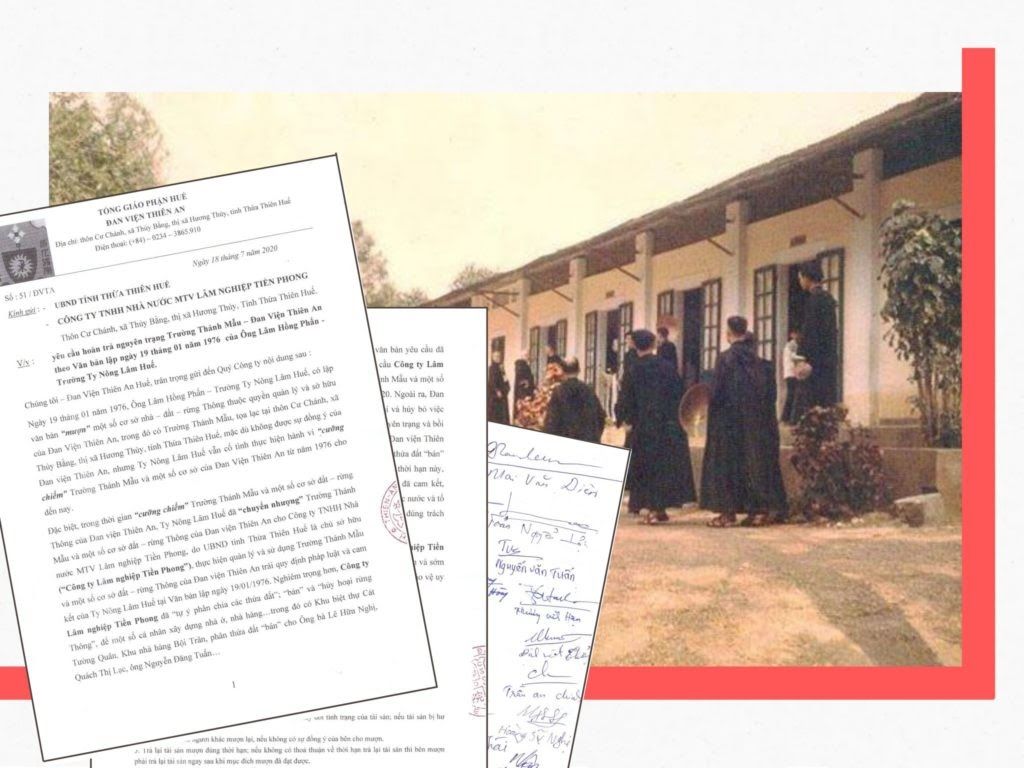
Petition dated July 18, 2020. Photo courtesy: Thien An Monastery
After 1975, the new regime interfered with the land rights of religious organizations in the south of Vietnam. The government extorted the lands of “unrecognized” religious organizations such as Hoa Hao Buddhism, Cao Dai, and the Baha’i Faith. For the “recognized” and larger religions, such as Catholicism and Buddhism, the government “borrowed” real properties and land from them.
Until the 2000’s, land disputes between the Catholic Church and the Vietnamese government continued to be tense as the regime began to permanently transform the land and real properties it had taken from religious organizations into development projects for both private enterprises and government businesses.
In 2013, the Archdiocese of Hanoi announced that there were 95 homes and real properties of the archdiocese currently being extorted by the government. In Ho Chi Minh City, about 400 homes and lands of the Catholic Church were confiscated by the government after 1975.
At the end of 2008, the government issued Decision 1940/CT-TTg to direct local authorities to review the lands and real properties which used to belong to religious organizations that the government confiscated or borrowed since 1975. In that decision, the government advised the local authorities to reassess how the lands and real properties that belonged to the religious organizations had been used so that they could decide if they would continue their use, return them to the organizations, or give the organizations other real properties to replace the ones that had been taken.
The details of how Decision 1940/CT-TTg was carried out in reality were not widely publicized. But we have found a report from the Government Committee for Religious Affairs in 2011 that summarized the results of over 2 years in compliance with Decision 1940/CT-TTg. The government stated that 7,102 religious structures in 33 provinces received the right to use land.
However, in 2015, Vietnam’s Ministry of Construction disclosed that the petitions and litigations regarding land rights involving buildings and real properties of religious organizations continued to increase and had become more complicated. These buildings and real properties all belonged to the category in which the Vietnamese government had borrowed or confiscated them.
Following the national election in 2016, it is almost certain that the government stopped discussing this decision in Vietnam.
At present, the land dispute between religious organizations and the government is mostly focused on the large and organized religions that have sufficient power to stand up to the government, such as the Catholic Church and the Protestant.
The other religions, such as the Buddhist Sangha of Vietnam, Hoa Hao Buddhism, Baha’i, Cao Dai, etc., seem to have accepted the government’s arrangement, or else do not actively make public the land rights problem between them and the government.
During the history of religious development in Vietnam, many of the real properties belonging to religious organizations were located in the highest priced lands around the country. Furthermore, with the fast economic development in Vietnam, many provincial governments have developed planning schemes for their cities which include lands belonging to religious organizations.
In 2015, the Redemptorist Church of Nha Trang strongly protested the decision of the government to lease an abbey located in one of the highest priced lands in the city. The government confiscated this abbey from the Redemptorists Church of Nha Trang in 1978. The church petitioned many times for the return of the abbey in 1996, 2006, and 2008, but these demands yielded no results. At present,, the government has leased this abbey to a private enterprise until 2062 for the construction of a commercial building and a hotel.
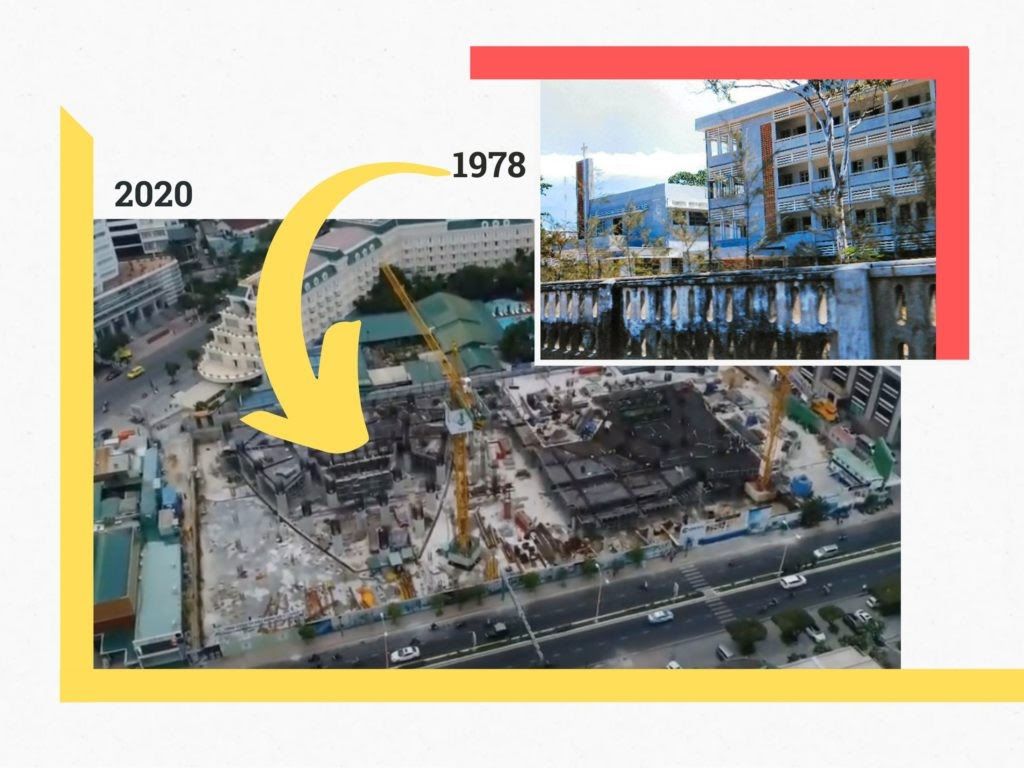
In the picture above, the abbey belonging to the Redemptorist Church of Nha Trang was confiscated by the government in 1978 (Smaller inset photo courtesy of the 459 Signal Battalion) and later became the Hai Yen Hotel. In 2015, the government continued to lease this land to build a commercial building and 40-story hotel. (Larger photo courtesy of Beau Rivage Nha Trang).
On the location beside the Saigon River next to District One – the financial center and the local government’s headquarters of Ho Chi Minh City – the government has been trying to gradually reduce the land and real properties once belonging to the Thu Thiem Congregation of the Holy Cross Lovers.
According to a RFA report, after 1975, the new regime “borrowed” a few schools operated by the Thu Thiem Congregation to build new public schools. In 2016, the government ordered the closure and abandonment of a cemetery belonging to the congregation. In 2018, the Ho Chi Minh City government ordered the relocation of the Thu Thiem Church to build new roads along the riverside. However, because of public outrage over that decision, one year later, the government agreed to not relocate the church, but that other real properties belonging to the church would be closed to accommodate the road building project.
The Carmelite Church in Hanoi also faced the same dispute with the government as the Thu Thiem Congregation, but was a lot less fortunate. From 2012 to 2016, the government started to demolish churches and monasteries that belonged to the Carmelite Church located at 72 Nguyen Thai Hoc Street, Hanoi, to build a new section of Saint Paul’s (Xanh Pôn) Hospital. The government has since completely demolished the churches and the monasteries of the Carmelite Church.
According to the Archdiocese of Hanoi, it had never authorized the transfer or donating of these lands and real properties to the government. In addition, the government is currently using four other locations belonging to the Archdiocese to run a hospital. The Archdiocese of Hanoi stated that the church and monastery of the Carmelite Church should not be demolished.
Religious organizations in Vietnam suffered tremendous losses when their lands and real properties were confiscated by the regime after 1975. More than that, the land policies during the last decades greatly hampered the ability of religions to grow and develop.
The government has established and maintained land policies designed to discriminate against religious groups.
In Vietnam, while the land theoretically belongs to all of the people, in reality, entrepreneurs and individual citizens can buy and sell land as the law allows people to “transfer and receive land usage rights.” However, religious organizations are not allowed to practice this right because they have to follow rules and regulations that only apply to religious groups.
Vietnam’s current Land Law 2013 specifies that religious organizations may only have land when the provincial government allows them to do so. Religious organizations recognized by the government have to petition provincial governments when they want to expand their real properties and land. The provincial government will decide whether to approve a petition or not. If people want to donate land to a religious organization, then the government will need to approve the request by a religious group to receive such land. The government then will receive the title of the lands and transfer it to the religious organization.
This policy has in fact limited the expansion of religious groups in Vietnam. Even when religious organizations gather enough money, they cannot freely buy land to expand their operations without government approval.
In 2014, the Baha’i Faith petitioned the government and requested that their lands and real properties that were confiscated after 1975 be returned to them. The Vietnamese government recognized the Baha’i Faith as a religion in 2008, but up until 2014, it still could not operate because it did not have any locations to build structures for their religion. As a result, six years after the religion was officially recognized by the government, the Baha’i Faith still has not received any of its former land or real properties to practice their faith. Compared to before 1975 when the group owned hundreds of locations to practice their religion, nowadays, the Baha’i Faith only has two locations. One is in Ho Chi Minh City and the other is in Danang.
Another issue with the government’s land policy is that these religious organizations have often gotten into trouble with the government.
One example is a case that happened in June 2020 in Ninh Binh Province. After receiving land from 12 individual households who wanted to donate them to the Dong Dinh Parish, the provincial government did not give the land to the parish. Instead, it announced that it will use the land between the parish and the 12 lots that these individuals wanted to donate to build a river-bank dike.
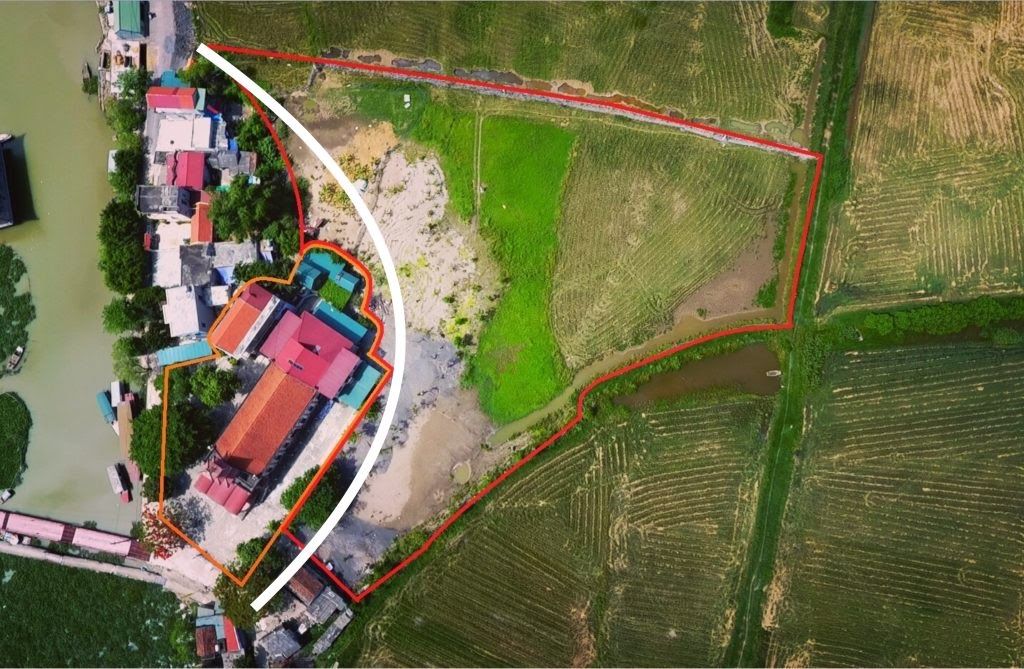
Dong Dinh Parish stated that the white curve in the photograph marks the donated land on which the government announced it would build a dike. Photo courtesy: Dong Dinh Parish.
The government often announced that it had provided sufficient assistance to religious organizations to obtain lands because it did not charge any administrative fee for land rights transfers. However, in reality, this land policy has prevented the development of religions in Vietnam. Religious organizations cannot develop and expand if they cannot freely engage in transferring land usage rights like any other individual or entity in Vietnam.
This land policy also created significant difficulty for religions that are not recognized by the government. It is illegal to practice religion on personal property in Vietnam. Therefore, religions like Hoa Hao Buddhism, CaoDaism, and the Unified Buddhist Sangha of Vietnam face the risk of being in conflict with the government.
According to Ha Tinh Newspaper, at 3 pm on July 18, 2020, the police of Cam Vinh Ward, Cam Xuyen District, Ha Tinh Province, reported that they had disbursed a gathering of 28 people who were practicing Falun Gong exercises at someone’s residence in that area.
A video of the incident recorded by the police showed 28 middle-aged people sitting together in front of a television, watching and practicing Falun Gong exercises.
Lieutenant Dang The Long, the head of the Cam Vinh Ward police, stated that the gathering of people to practice Falun Gong, which is not a religion recognized by the government, was unlawful and could disturb the peace in the area.
At present, Falun Gong practitioners often gather in public parks and on beaches to practice. So far, there have not been any reports that police were intervening in the practice of Falun Gong. However, the government does not allow people to gather in large groups in a private residence to practice Falun Gong.
From March to May 2020, the police of Ha Tinh Province fined at least five individuals for disseminating materials about Falun Gong.
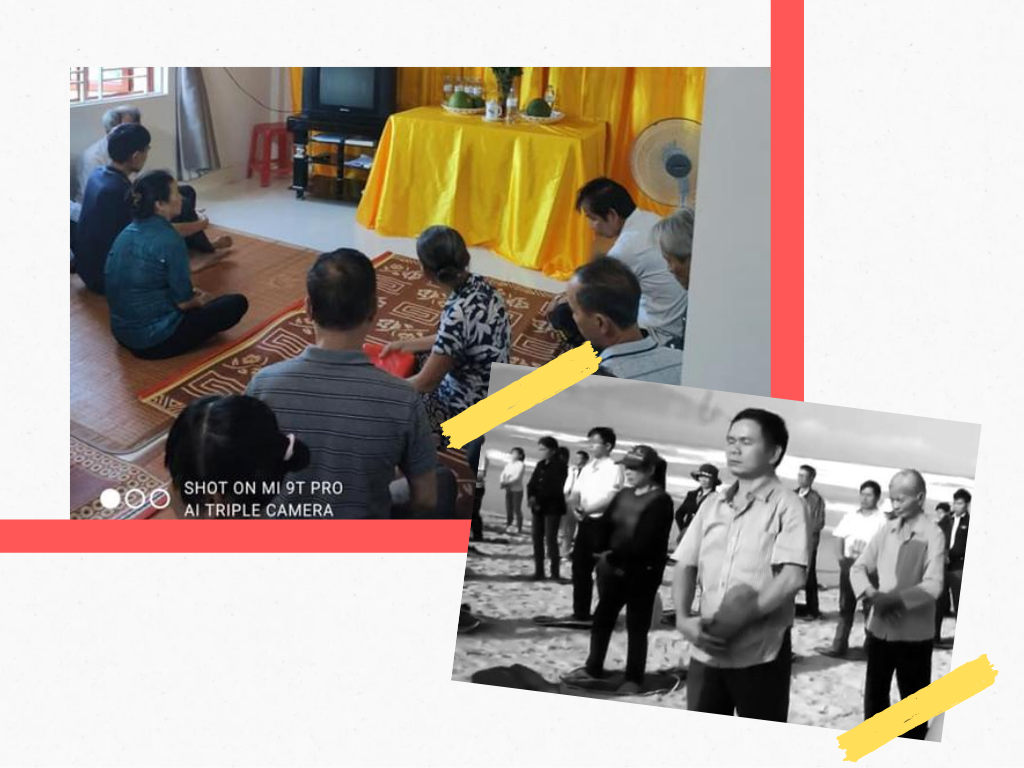
Twenty-eight Falun Gong proselytizers in a home where the Ha Tinh Police conducted an investigation. (Top photo courtesy: Ha Tinh News). A group of Falun Gong practitioners practice at a beachside in Danang. (Bottom photo courtesy: Youtube/Nguyen Trong The).
On July 24, 2020, Nguoi Viet Daily News, citing information from social media, reported a disciplinary decision by Ha Tinh Radio and Broadcasting to discipline an announcer because he had disseminated Falun Gong materials.
According to the news report, the announcer disseminated information about Falun Gong on his social media account. This conduct was found to be a violation of his company’s “policies and internal regulations.” The order also stated that formal disciplinary action will be decided after the matter has been thoroughly investigated.
In June 2020, a principal of a high school in Quang Tri Province was disciplined after he gathered a group of people to practice Falun Gong at his house.
Independent journalist Vo Ngoc Luc reported that on July 17, 2020, Pastor Nguyen Ngoc Khanh was interrogated by the police of Buon Me Thuot City, Dak Lak Province. The police stated that the interrogation was related to a “meeting with foreign individuals and organizations.” Prior to his interrogation, Pastor Nguyen Ngoc Khanh had met with a group from the United States to discuss freedom of religion.
Similarly, Mr. Y Kuan E Ban (often referred to as Ama Sim) was also interrogated by the police of Cuor Dang Ward, Cu M’gar District, Dak Lak Province. The local authorities came to his house during the night of July 15, 2020 and asked him to cooperate with them. The local government investigated him at his home and stated Y Kuan E Ban “had practiced Protestantism unlawfully” with 40 other people and asked him to go to the People’s Committee Office of the ward the next day. The next day, Y Kuan was interrogated by the local authorities about his meeting with the American group about freedom of religion.
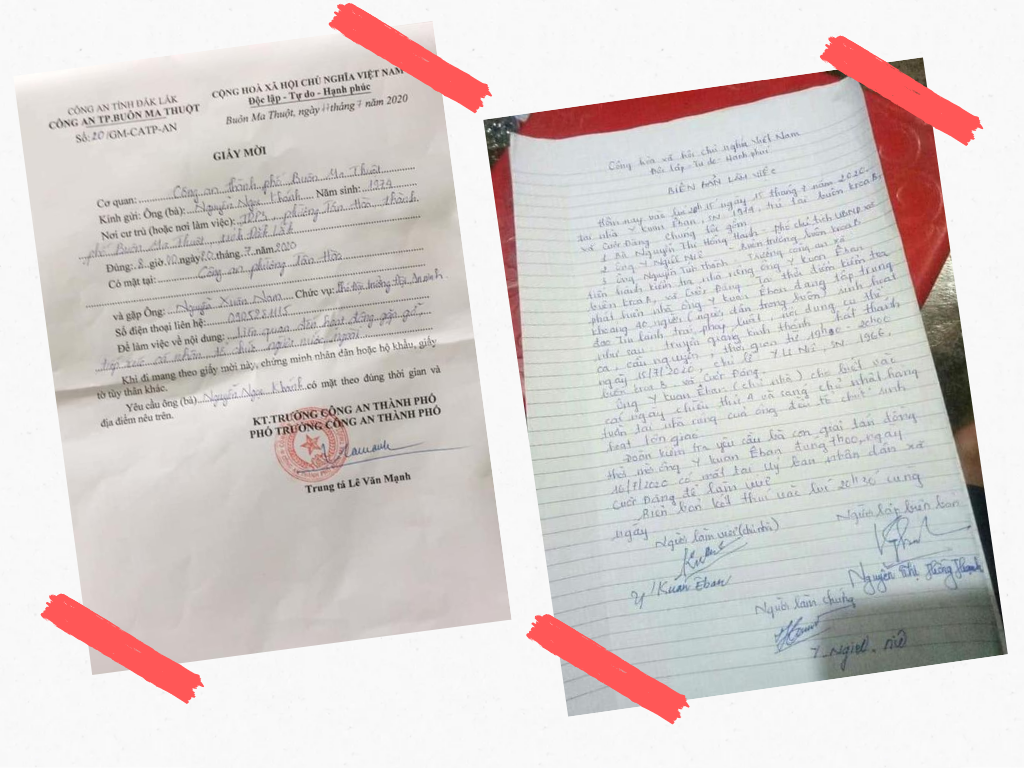
On the left, the invitation to Pastor Nguyen Ngoc Khanh; on the right, the investigative report of Y Kuan E Ban. Photo courtesy: Vo Ngoc Luc
Another case was reported by Human Rights and Justice for Indigenous People of Vietnam. Specifically, the Cu Kuin District police invited Mr. Y Quy Bdap and Pastor Y Khen Bdap to their station on July 23, 2020 to discuss “how to work together to ensure public safety in that location.”
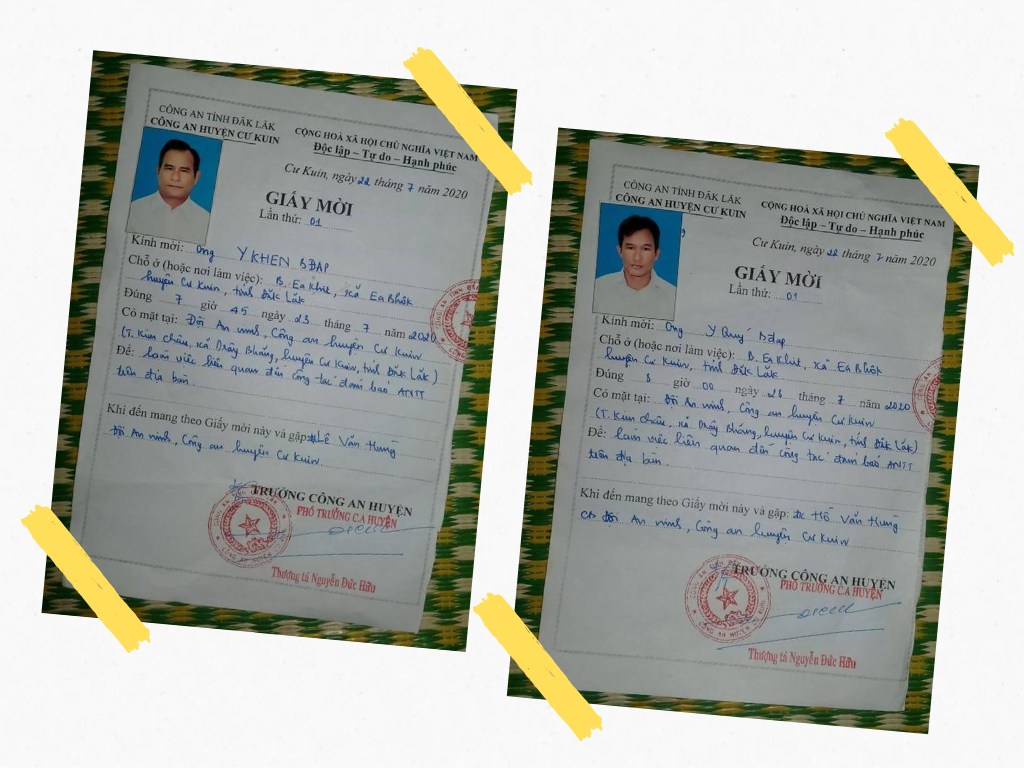
The invitations were sent by the police of Cu Kuin District to Pastor Y Khen Bdap and Y Quy Bdap on July 22, 2020. Photo courtesy: Human Rights and Justice for Indigenous People of Vietnam.
However, during the interrogation on the morning of July 23, 2020, both men were only asked about their meeting with the American group to discuss freedom of religion. The police accused them of participating in human rights work and alleged that they had made false statements about Vietnam. Both men reported that they were threatened and verbally abused by the police during the interrogation.
After the interrogation, the police requested that the two men continue to be interrogated in the afternoon, but they both refused citing health reasons. In the evening, after they failed to return to the police station, the police sent seven security police to their houses and forced them to go to the station. The family of Y Qui Bdap protested and prevented the police from forcing him to go.
Human rights activists and religious rights activists are often interrogated by the police after they meet with groups from foreign countries. The government uses this tactic to investigate the content of meetings and to also prevent activists from criticizing Vietnam when speaking with foreign officials.
According to the Gia Lai Police Department Newspaper, on July 4, 2020, the police of Ia Grai District, Gia Lai Province brought a Montagnard, Puih Hong, 40, to a public criticism session at Cham Village, Grand Ward.
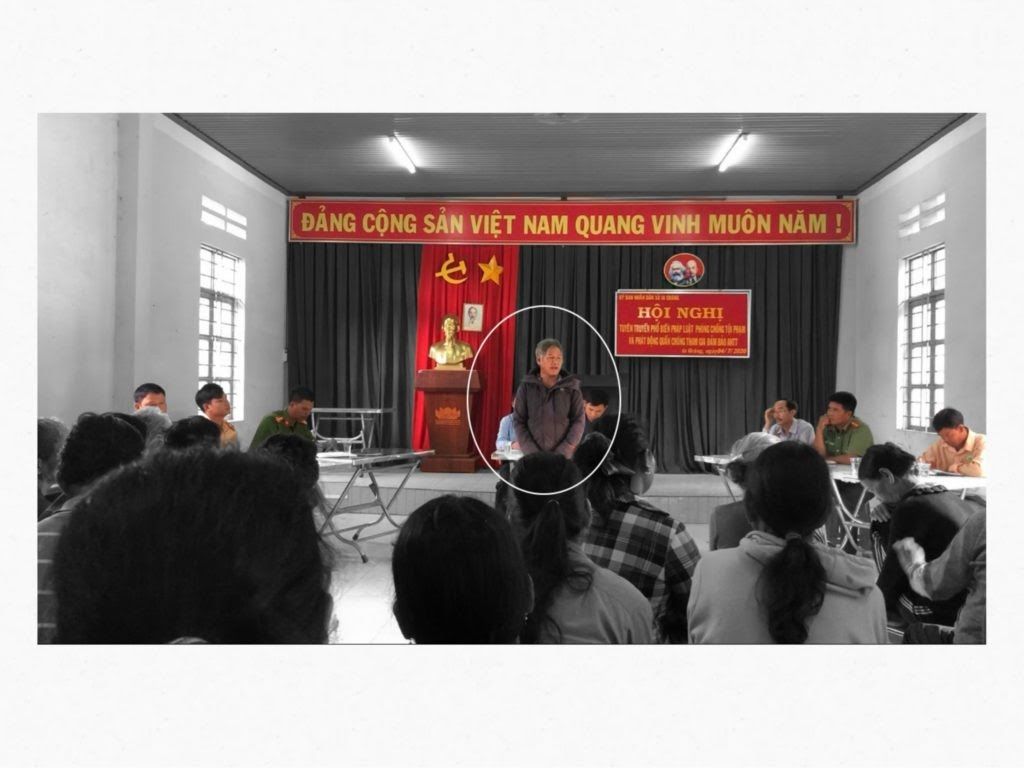
Puih Hong at the public criticism session on July 4, 2020. Photo courtesy: Gia Lai Police
A public criticism session is a method that the police frequently use to intimidate people in the Central Highlands. The subject of the criticism session has to stand in front of his neighbors and admit to crimes he has been alleged to have committed.
At this public criticism session, Puih was accused of distributing information about De Ga Protestantism and it was alleged that he had “defamed the religion laws and the great unity of the government.” Puih was also accused of illegally escaping to Cambodia between June 2017 to May 2020 after which the Cambodian government deported him back to Vietnam.
On July 24, 2020, a report accused the Montagnard Evangelical Church of Christ of being anti-government and of mobilizing people to secede from Vietnam to form an autonomous region in the Central Highlands. This report was broadcasted on the Security Police Television under the Ministry of Public Security.
In this report, the Senior Lieutenant Colonel Truong Hong Quy, who is the head of the Domestic Security Police Bureau of the Dak Lak Province Police Department, stated that a few individuals had used religion to mobilize and propagandize the people to secede and become opposed to the Vietnamese government. In this specific case, the Montagnard Evangelical Church of Christ was cited.
Quy also said that the Montagnard Evangelical Church of Christ received financial resources from overseas to mobilize people to be anti-government.
Colonel Nguyen The Luc, the deputy director of the Dak Lak Province Police Department, also stated that the group had used religion to engage in anti-government conduct and that it now used the Montagnard Evangelical Church of Christ. According to the police, before that, practicing De Ga Protestantism was used to mobilize people.
This report also alleged that members of the Montagnard Evangelical Church of Christ were former members of FULRO, that they had participated in anti-government protests and were being imprisoned at re-education camps. The arrested included Y Jol Bkrong, Ksor Sun, Y Kou Bya, Y Nia Ayun, Y Nuen Ayun, and Y Nguyet Bkrong.
Throughout this report, one can see that the Dak Lak Province Police Department has a firm belief about the character of the Montagnard Evangelical Church of Christ and that the department will try its best to dissolve the religious group.
The Administrative Council of Hoa Hao Buddhism announced that it was prevented from entering its temporary religious site in Long Giang Ward, Cho Moi District, An Giang Province from July 6-8, 2020.
On the evening of July 8, 2020, the Administrative Council was allowed to enter the site to perform rituals to commemorate the day Founder – Master Huynh Phu So – established Hoa Hao as a religion.
In previous years, during big celebrations to commemorate certain events and anniversaries of Hoa Hao Buddhism, its followers faced harassment and were prevented by the government from practicing their beliefs. The security police often set up posts to control followers going to their religious sites.
According to Tuoi Tre News, as of July 2016, 22 religious sites were willing to relocate from their current locations to new places. These 22 religious sites were originally located in the area that had been assigned for the construction of the new urban compound at Thu Thiem, District Two, Ho Chi Minh City.
The article strongly emphasized that these religious organizations agreed to transfer their lands to the government and to be moved to other locations. However, it also targeted the Lien Tri Temple and spread news that the temple was not willing to relocate like others. However, Lien Tri Temple belongs to the Unified Buddhist Sangha of Vietnam, which was organized and founded before 1975, and it is not recognized as a religion by the current government.
Thich Khong Tanh, the abbot of the Lien Tri Temple at the time, stated that other religious organizations were willing to relocate because they received compensation and were given lands with higher prices. At the same time, the Lien Tri Temple did not receive similar equal treatment.
The government announced that it would demolish the temple in July 2016. On September 8, 2016, when it could not reach an agreement regarding the compensation with Lien Tri Temple, the government sent its forces to occupy and demolish the structure.
The monks who used to live at Lien Tri Temple disbursed themselves and were allowed to live in other temples; the government has yet to compensate them.
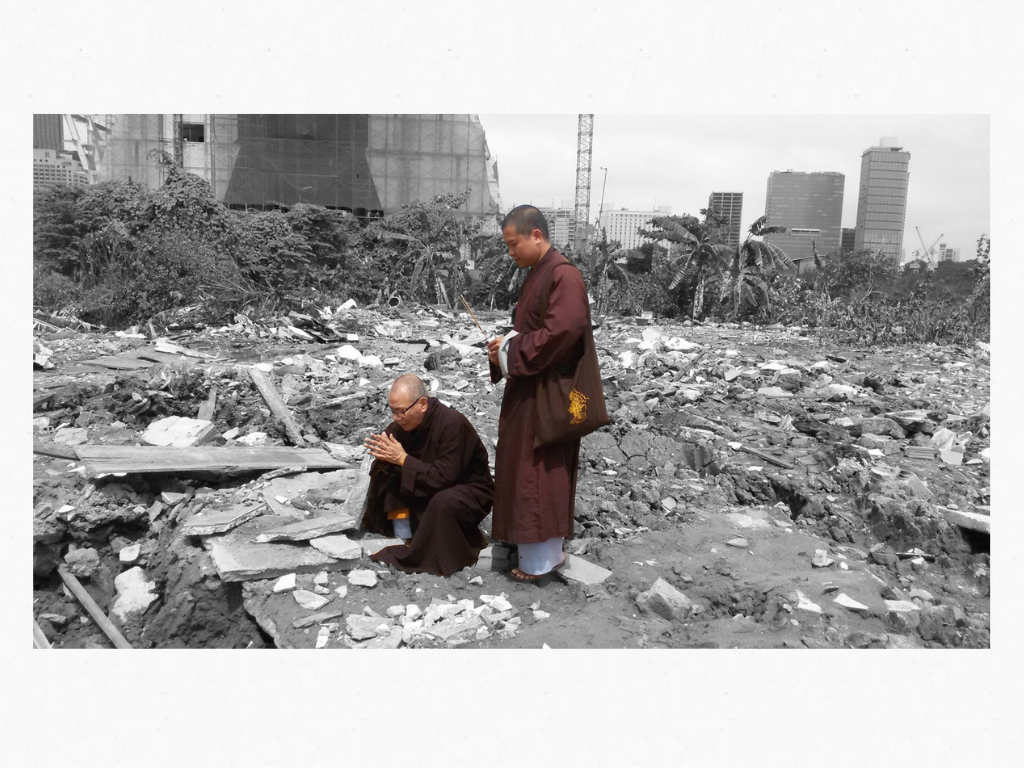
Thich Khong Tanh, abbot of Lien Tri Temple, sits on the grounds of the collapsed temple after the government forced its demolition. Photo courtesy: Quang Duc
The national census of 2019 showed that a lot of religions suffered significant decreases in the numbers of their followers, including four religions which saw a decline of more than 90 percent.
Three of the religions, which include Ta Lon Dutiful and Loyal Buddhism, Vietnam Pure Land Buddhist Association, and Southern Buddhism Minh Su Faith, suffered more than a 90 percent decrease in the number of their followers in the past decade. The Baha’i Faith also suffered a loss of 90 percent of its followers since 1975.
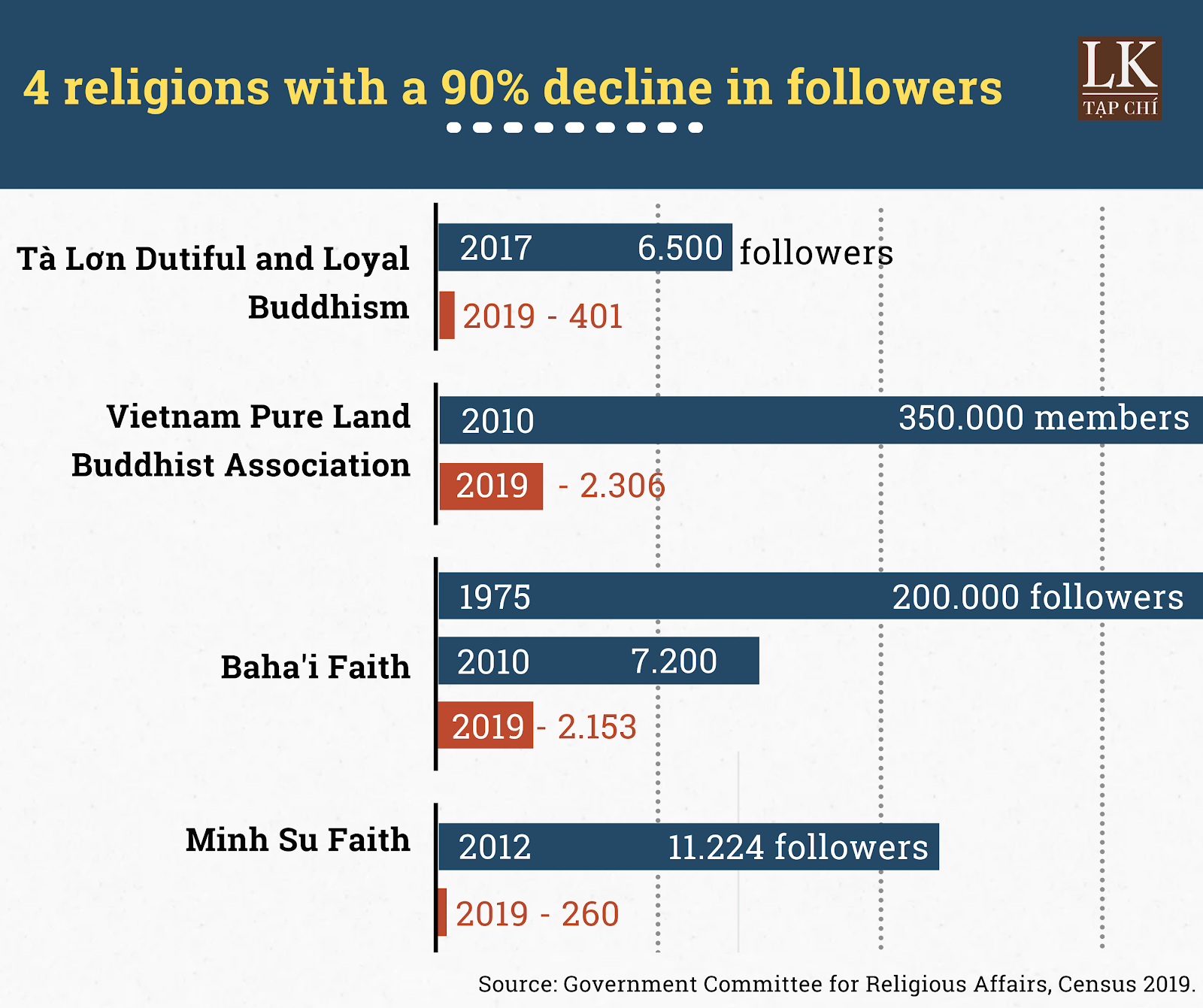
In a report published in 2017 by the Government Committee for Religious Affairs, it was reported that Ta Lon Dutiful and Loyal Buddhism had 6,500 followers. But only after two years, the Census of 2019 showed that the number of followers had fallen to just 401. Ta Lon Dutiful and Loyal Buddhism was founded in 1915 in Kien Giang Province with beliefs in Buddhism and Confucianism.
Among the Buddhist sects in Vietnam, the Vietnam Pure Land Buddhist Association was viewed as the sect that had the most followers. The Government Committee for Religious Affairs reported that it had about 1.5 million followers and 350,000 members in 2010. Nevertheless, in 2019, the number of followers of this sect had decreased to 2,306 followers.
The Census of 2019 also reported that the Southern Buddhism Minh Su Faith only had 260 followers. In 2010, the Government Committee for Religious Affairs reported that the group had 11,224 followers.
The Baha’i Faith has waited 33 years for the government to recognize it as an official religion which happened in 2008. In 2010, it had about 7,200 followers. At present, the current number of followers of the Baha’i Faith is about 2,153, a 90 percent decline compared to the 200,000 followers it had before 1975.
Furthermore, seven other religions suffered a loss of 50-80 percent in the number of their followers. Those religions include Caodaism, Tu An Hieu Nghia, Giao hoi Co Doc Phuc Lam, and Hoa Hao Buddhism. A few other religions also suffered a loss in followers during the last decade, including Buu Son Ky Huong, and Hoi thanh Minh Ly Dao – Tam Tong Mieu.
Vietnam's independent news and analyses, right in your inbox.